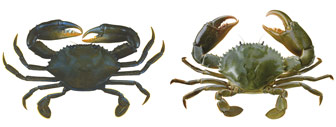
Left: brown mud crab, right: green mud crab.
While Western Australia's commercial mud crab fishery is only small, producing up to five tonnes annually, mud crabs are prized by recreational fishers for their impressive size and taste.
In WA there are two species: Scylla serrata (known as the green mud crab in WA) and Scylla olivacea (known as the brown mud crab in WA). The green mud crab grows up to 2.5 kg and 300 mm wide (across its carapace, the hard shell covering its body). The brown mud crab is smaller – it grows up to 1.5 kg and 150 mm carapace width.
Habitat and distribution
Mud crabs are found in WA's north-west from Shark Bay to the Northern Territory border. They like sheltered waters such as estuaries and mangrove areas. Many live in burrows where the land is exposed at low tide. However, most adults live in shallow areas below the low tide mark, where they bury themselves in the mud during the day.
Lifecycle
- Zoea – A mud crab begins life as a larva called a ‘zoea’, which hatches from an egg. It is about one millimetre long, has undeveloped limbs, and floats with the plankton.
- Megalopa – A zoea grows by ‘moulting’ (shedding its shell) four times over 12 to 15 days. During the fifth moult, it transforms into a ‘megalopa’, which has functional claws. After a week or so, it moves inshore and settles to the seabed. After a few days, it moults into a stage one juvenile crab.
- Juvenile crab – A miniature version of the adult, it is about 4 mm wide. About a month after hatching, when 10 – 20 mm wide, it moves to an estuary and settles in a sheltered area.
- Young adult – The crab reaches sexual maturity at 18 to 24 months.
- Mating – In the warmer months, mature females release a ‘pheromone’ (chemical attractant) into the water to attract males. Once paired, the male climbs on top of the female, clasps her with his hind legs, picks her up and carries her around for up to four days. He releases her when she begins to moult, and after she has shed her shell, he turns her upside down to mate. He deposits a capsule of sperm inside her reproductive opening, where it’s stored for months until her developing ‘ova’ (eggs) are ready to be fertilised. After mating, the male flips the female upright and holds her under him for a few more days while her shell hardens.
- Spawning and hatching - The female migrates offshore to spawn. The fertilised eggs are released in batches of two to five million. After digging a hole in the sand or mud with her abdominal flap, the female releases her eggs into it. Using her swimming legs, she gathers the eggs up to carry them under her abdomen. The eggs hatch in two to four weeks. The lifecycle then begins again.
Diet
Mud crabs emerge at night to forage for food; they eat almost anything. However, they mainly eat slow-moving or stationary bottom-dwelling animals such as molluscs, smaller crabs and worms. They also eat plant material.
Predators
In the larvae stage, when floating with the plankton, they can be eaten by small fish. It is presumed that in the post-larvae and juvenile stages they are preyed on by fish species that live in mangrove areas. Adult mud crabs have fewer predators. However, turtles, rays, crocodiles and large fish, such as barramundi and sharks, prey on adult mud crabs.
More information
For more information see our Mud Crab  fact sheet.
fact sheet.